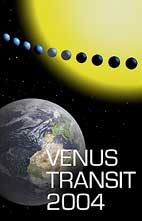 |
 
|

|
||||||||
| 2004-2012: the transits of Venus
Short presentation of the event What happened on June 8, 2004? What will happen on June 5-6, 2012? On June 8, 2004, a rare phenomenon occurred: the planet Venus passed in front of the Sun. A rare phenomenon, indeed, because nobody living today had never saw a transit of Venus in front of the Sun before June 8, 2004: the last transit took place in 1882 and was only partially visible in Europe. The same event will occur again on June 5 and 6, 2012: don't miss it: the next one will occur only in 2117! Such a rare phenomenon mobilizes all who are curious about the sky, but it also enables us to go up with the bases of our knowledge of the universe. Below on the left, one of the rare existing photographs of the solar disc and the Venus disc at the time of the transit of 1882. On right-hand side, an image made with the heliograph in Meudon observatory on June 8, 2004. 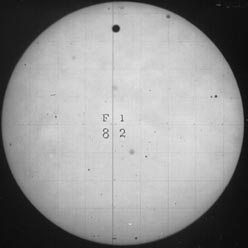 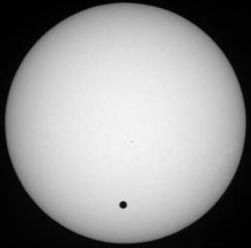 What is a Venus Transit? Quite simply, it is the celestial phenomenon of the transit of the dark disc of the planet Venus in front of the shining disc of the Sun. It is, in fact, a partial eclipse of the Sun, very partial since the planet Venus will occult only a very small part of the solar disc, but which will be very easily observable for an informed public of the phenomenon. One will find below the forecast of the zone of transit of the Venus disc on the Sun on June 8, 2004 between 5h 06m and 11h 33m Universal Time (UTC). On June 5-6, 2012, the transit will start on June 5 at 22h 03m and will end on June 6 at 4h 56m UTC (plus or minus 5 minutes, depending on the observing site). 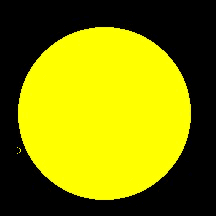 Why such a phenomenon is so rare? The planet Venus orbits around the Sun in 225 days between the Earth and the Sun. We should thus see this phenomenon at each revolution, i.e. each conjunction between Venus and the Sun, every 584 days. It would be true if Venus and the Earth were orbiting around the Sun in the same plane. The orbital plane of Venus being tilted of 3 degrees approximately on the orbital plane of the Earth, the planet Venus will pass generally above or below the solar disc and we will not see a transit. The figure below shows the phenomenon. 
It is then easy to understand that here is only one possibility for a transit: it is necessary that the Sun, Venus and the Earth are aligned on the intersecting line of the two orbital planes (called line of the nodes). The Earth crosses this line in June and in December but Venus is simultaneously there only very seldom, approximately twice by century as the table shows it below (dates of transits):
One will refer to the specific pages clarifying the calculation of the transits and in order to understand this periodicity. Why this phenomenon is so important? In addition to his scarcity, this phenomenon of transit allows us to point out fundamental elements of our knowledge of the universe, in particular, how we measure the distance to the stars and the size of the universe. This measurement is not simple: it is impossible to go towards the celestial bodies and to measure their distance to the Earth in situ: all the stars and the planets which are seen on the celestial sphere seem to be at the same distance from us: an argument will be necessary to estimate these distances. The observation of the transit of Venus was the most famous
observation to measure the distance from the Earth to the Sun,
distance which is the key and the measuring unit of all the
other distances between the celestial bodies. It is time to remind
this human adventure of measurement of our
universe.
What suggests us the Venus Transit? The Venus transit allows us to remind the history of sciences, more particularly at the XVIIIth century, where the people was enthusiastic to the work of these astronomers ready to go at the end of the Earth with the risk of their life (some will not return from there) to hitherto observe this phenomenon which was going to provide us the size of our universe, very badly known. Why such a travel so far whereas the phenomenon is visible from Europe? It is the concept of parallax, triangulation, measurement of a distance from the measurement of angles which are then highlighted. The study of this concept will also lead us to the methods used to measure the distance from stars and the galaxies. The Venus Transit brings also our attention to the complex motion of the planets around the Sun, the Kepler's laws, dynamics, gravitation. The scarcity and the periodicity of the passages show us also the difficulty of astronomical calculations for the prediction of celestial phenomena. This phenomenon recalls us also all the other phenomena of occultations and eclipses (Moon and Sun eclipses, phenomena of Jupiter's satellites which highlighted the speed of the light) in the solar system and also our search for planet transits in front of other stars, highlighting extra-solar planets being able to have the same size as the Earth. Lastly, this phenomenon has a strong teaching value:
it could be observed by all making possible to recompute the distance
Sun-Earth. One will compare his own measurement with the
value obtained with modern measurements today. To make this measurement,
the dimension of international collaboration will
be highlighted: impossible to measure the distance Sun-Earth
without having a measurement made far from us- what justified the voyages
made during the XVIIIth century and what will motivate us to make
contact and collaborate with far observers. One will find
below the chart showing the zones of visibility of the Venus transits of June
8, 2004 and on June 5-6, 2012 on the Earth (zone V).


How to observe and what to observe? It should not be forgotten that the observation of the Sun is dangerous and that it is necessary to be prepared to observe the Venus Transit in full safety. Only the methods of observation by projection are sure. The direct observation, even with a filter, will have to be done by the intermediary of a webcam which will record the images and will make it possible to make measurement after the observation. 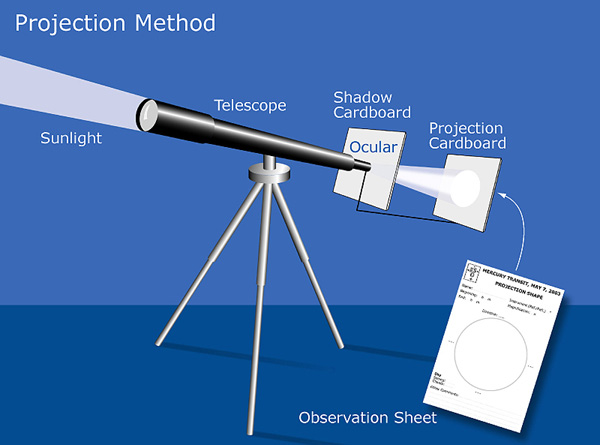 All the instructions were given on this site to observe and send observations to a central site which has calculated the distance Sun-Earth using all the measurements made. The calculated distance will be as precise as the number of observations will be large. According to the material of observation available, various measurements will be possible to make by the pupils of high schools and by the amateur astronomers. Sites of observation were open for those who do not have the possibility of doing themselves the observation. Images are also available on the Web through Internet. Note that between 2004 and 2012, it will be interesting to observe the Sun for the solar eclipses on October 3, 2005, March 29, 2006 and January 4, 2011. Where to find information necessary? All useful information to know more is available on the site of IMCCE: -
pedagogic sheets on the transit of Venus and all the topics
related: -
how to make a virtual observation of a transit of Venus -
databases providing the observations made : -
detailed explanations of the phenomena (in french) -
explanations to carry out the observation
yourself: |